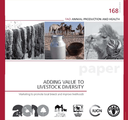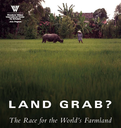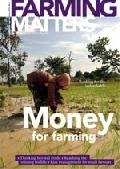Adding value to livestock diversity: Marketing to promote local breeds and improve livelihoods
Evelyn Mathias (ed.), 2010. LPP and LIFE Network / FAO, 142 pages.
Downloadable at: http://www.fao.org/docrep/012/i1283e/i1283e.pdf

Land grab? The race for the world’s farmland
Michael Kugelman and Susan L. Levenstein (eds.), 2009. Woodrow Wilson International Center for Scholars, 123 pages.
Downloadable at: www.wilsoncenter.org/topics/pubs/ASIA_090629_Land Grab_rpt.pdf

Realising REDD+: National strategy and policy options

Downloadable at: www.cifor.cgiar.org/Knowledge/Publications/Detail?pid=2871
Deforestation and changes in land use account for up to 20 percent of all greenhouse gas emissions. The idea of “rewarding” governments, companies, forest owners and users in the south for keeping and maintaining their forests would seem a logical step for any post-Kyoto agreement. Current discussions now focus on REDD+, a strategy that considers forest management and different approaches to enhance forest carbon stocks, which it is hoped might prove effective. But many details remain. Who owns the forests? And what institutions are required in order to make this work? This book aims at helping those interested in making such a system operational: looking at the “institutional architecture” which is needed and at policies and how these, via incentives or regulations, could help increase forest conservation.
Entering the organic market: A practical guide for farmers’ organisations
Freek Jan Koekoek, Marg Leijdens and Gerbert Rieks, 2010. Agrodok 48, Agromisa, 88 pages.
Downloadable at: www.agromisa.org/displayblob.php?ForeignKey=460&Id=303
In spite of the world’s economic crisis, global demand for organic products has continued to grow during the last two years. More and more organic farmers are benefiting from selling their products in international markets and many more are expected to join them. This is an easy-to-read and complete guide for those interested in exporting organic products. It draws on the experience of the EPOPA programme, which ran from 1997 to 2008 and benefited more than one hundred thousand farmers from Uganda and Tanzania. The booklet first gives an overview of the organic market and the importance of the certification process. This is followed by describing the steps involved in making a business strategy: a feasibility study, risk analysis, marketing, planning and evaluations.
Fair miles: Recharting the food miles map

Downloadable at: www.iied.org/pubs/pdfs/15516IIED.pdf
In this short, concise and beautifully presented booklet, IIED and Oxfam GB look at “food miles”, a much discussed concept in recent years. The constant increase in food trade between developed and developing countries is often seen as an important source of greenhouse gases and as contributing to climate change. The authors dispel this perception somewhat, showing that transportation is only responsible for 10 percent of all emissions associated with the UK’s food chains. It also argues against the idea that locally produced foods are necessarily better in terms of global warming, since they often require more energy to grow. Equally, the term “local” can be misleading, if most inputs come from developing countries.
Trade, climate change and sustainable development: Key issues for small states, least developed countries and vulnerable economies
Moustapha Kamal Gueye et al. (eds.), 2009. Commonwealth Secretariat, 180 pages.
Some argue that increasing international trade can help to mitigate the effects of climate change. But is this true for the least developed countries? Or are these countries facing additional difficulties as a result of actions being taken against climate change? Although this book was finished before the Copenhagen conference at the end of last year, it addresses these questions in detail, looking at the opportunities and the main challenges which these countries face (and at the difficulty with issues such as “food miles”, which could easily become a hidden trade barrier). The different chapters cover issues such as energy efficiency and competitiveness in the global markets, showing the importance of resilience and diversification in all economic sectors – including agriculture.
More on agricultural and rural finance
A lot of interesting information on this issue is found online. Among these, readers can visit the sites of Microfinance Focus, the Rural Finance Network, the Microfinance Gateway, the Finance Alliance for Sustainable Trade, and of the Rural Finance Learning Centre. These websites include articles, documents, general information and also news items. The list of documents which can be downloaded includes “The missing middle in agricultural finance” (Alan Doran, Ntongi McFadyen, and Robert Vogel, Oxfam, 2009).
This presents a thorough analysis of the needs of small- and mediumsized enterprises, and of the challenges in supporting them. Although a few years old, two IFAD publications are also very relevant: “Managing risks and designing products for agricultural microfinance” and “Emerging lessons in agricultural microfinance”. A very complete (and recent) publication is “Expanding the frontier in rural microfinance”, edited by Maria Pagura (Practical Action and FAO). Drawing on 12 case studies, it gives a very complete overview, showing the many different strategies followed in the field. More specific documents include “Value chain finance” (KIT, 2010), “Assessing the role of microfinance in fostering adaptation to climate change” (Agrawala Shardul and Maëlis Carraro, OECD, 2010), and “Gender and rural microfinance” (Linda Mayoux and Maria Hartl, 2009). Finally, readers may also be interested in visiting the sites of microfinance organisations like Oikocredit, Triodos or the Grameen Bank.

